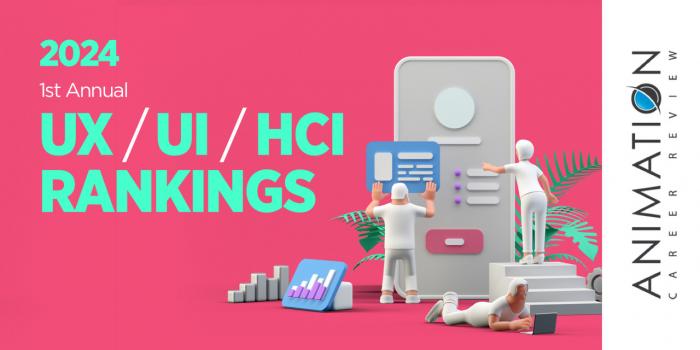
35+ Years of Shaping Entertainment and Pop Culture - From Oscar and GRAMMY-winners, to animators, to creative directors and entrepreneurs, our graduates make significant contributions to their industries. Learn More.

| Ranking | School | State |
|---|---|---|
| 1 | University of Washington | Washington |
| 2 | University of California, San Diego | California |
| 3 | Stanford University | California |
| 4 | California College of the Arts | California |
| 5 | Academy of Art University | California |
Our 2024 rankings of the Top 5 undergraduate UX/UI/HCI school programs on the West Coast. For an explanation of ranking criteria, click here.

The College of Engineering at University of Washington (UW) is the number one source of all UW start-ups and a national leader in women in engineering. Serving approximately 5,615 undergraduate students, UW College of Engineering also houses one of the nation’s top Human Centered Design & Engineering (HCDE) programs.
At the undergraduate level, students can earn a BS in HCDE. This competitive program attracts students in their second year of study at the University of Washington. With three major areas of learning including design, technicality, and social scientific, the HCDE program requires 180 credit hours in general education, core and electives, and free electives. Course examples include Interaction Design and Prototyping; Empirical Traditions in Human Centered Design and Engineering; User-Centered Web Design; Inclusive Design and Engineering; Human Data Interaction; and Interactive Systems Design and Technology.
Through the experiential learning requirement, students will have the opportunity to complete an internship, study abroad course, or directed research in HCDE.
Graduates of the HCDE BS program at University of Washington are prepared to pursue positions that involve creating information visualizations, designing for the web, conducting user research, building web technologies, and designing user experiences and interfaces. HCDE graduates hold positions such as UX/UI Designer, User Experience Researcher, Interaction Designer, Consulting Development Analyst, Product Designer (Internet & Software), Program Manager, and Software Architecture Analyst.
Examples of companies and organizations that have hired UW HCDE alumni include Boeing, Amazon, Google, Disney, Microsoft, Apple, T-Mobile, NBC Universal, Accenture, GE Digital, Capital One, Alaska Airlines, Intel, Expedia Group, IBM Designs, Intuit, Lyft, GoDaddy, Razorfish, Verizon, Publicis Sapient, Getty Images, Raytheon Technologies, Adobe, Nike, Starbuck’s, Cisco, Uber, Bungie, Inc., and Getty Images.
Established in 1861, University of Washington serves approximately 60,095 students across campuses in Seattle (main), Bothell, and Tacoma, Washington. Collectively, these campuses provide more than 470 programs and 845 degrees housed across 18 colleges and schools. University of Washington is accredited by the Northwest Commission on Colleges and Universities (NWCCU) and is a member of the Association of American Universities (AAU). UW Engineering is accredited by the Accreditation Board for Engineering and Technology (ABET).

The University of California, San Diego (UC San Diego or UCSD) is home to the School of Social Sciences. Founded in 1986, this interdisciplinary school houses 16 departments and programs, including the Department of Cognitive Science (CogSci). The UCSD Cognitive Science community dates back to 1961 and the establishment of the Cognitive Science Society took place in 1979. The Department itself was established around the same time as the School of Social Sciences, making it the first CogSci Department in the world.
Within the CogSci Department are eight undergraduate degree programs and two minors. This includes a BS in Cognitive Science with a specialization in Design and Interaction. With a focus on project-based coursework, the program is designed for students interested in UX design, HCI, mobile app development, web design, usability research, and product design.
The program begins with lower division courses such as Design, Neuroscience, and Programming. Upper division requirements consist of 48 units or 12 courses including a combination of cores and electives. Course examples include Data-Driven UX/Product Design; Advanced Interaction Design; Cyborgs Now and in the Future; Design for Future Creativity and Productivity; HCI Technical Systems Research; Social Computing; Cognitive Design Studio; Information Visualization; Thinking with Computers; and Usability and Information Architecture.
Students have the opportunity to participate in the internship program, study abroad experiences, practicums, and the HCI Portfolio Design Studio.
The Cognitive Science/Design and Interaction BS program at University of California, San Diego culminates with a final online portfolio of the students best work. Graduates are prepared to pursue an advanced degree in UX/UI/HCI or positions such as UX/UI Designer, HCI Specialist, UX Researcher, Graphic Designer, Front-End Programmer, Mobile App Developer, Data Visualization Specialist, Product Manager, Web Designer, Project Manager, Tech Entrepreneur, Software Engineer, and Product Designer.
University of California, San Diego is one of the top 15 research universities worldwide. Founded in 1960, UCSD serves 42,300 students enrolled in more than 100 degrees and programs across six undergraduate colleges, five academic divisions, and four graduate and professional schools. University of California, San Diego is accredited by WASC Senior College and University Commission (WSCUC).

The School of Engineering at Stanford University was established in 1925. Serving more than 1,500 students, the School houses nine academic departments and several institutes. The interdisciplinary Hasso Plattner Institute of Design (also known as "the d.school") brings together faculty and students in business, engineering, education, humanities, and medicine to learn design thinking and address problems in a human-centered way. The Woods Institute for the Environment is a collaboration between students, staff, and faculty from the centers and institutes at Stanford. The Institute highlights education, interdisciplinary research, and outreach with a focus on the environment and sustainability.
Another Stanford Engineering highlight is Global Engineering Programs (GEP). Through GEP, students have access to international opportunities such as self-designed engineering internships. These internships allow students to learn about technology and engineering in a global context; gain real world experience in an environment; and build professional networks.
Also within Stanford School of Engineering are 16 departmental and interdepartmental undergraduate majors that provide hands-on opportunities, traditional lectures, interactive learning, and the opportunity to enroll in a double major. Established in 1965, the Computer Science Department here also provides the opportunity to enroll in a track in in-demand areas such as Artificial Intelligence (AI), Information, and Human-Computer Interaction (HCI).
Leading to a BS, the Computer Science major with an HCI track is a multidisciplinary program that explores user-centered design with a focus on rapid prototyping, innovative and new interaction techniques, universal computing, and creativity tools. Also offered as a concentration in the Symbolic Systems BS program within Stanford’s School of Humanities & Sciences, coursework for the HCI track explores topics such as Interaction Design; Sketching and Modeling; Process Capability; Interface and Graphic Design; Ethics in Content; and Information Architecture.
Course examples include Introduction to HCI Design; Human-Computer Interaction; Designing Serious Games; Object-Oriented Systems Design; Foundations and Frontiers; Design for Behavior Change; Service Design; Design for Understanding; Design for AI; Interaction Design Studios; Understanding Users; Cognition in Interactive Design; and Design for Play.
Students in the Computer Science-HCI program at Stanford University will complete a User Interface Design project, which consists of designing, prototyping, and evaluating user interfaces and computing applications.
Graduates are prepared for careers in Computer Science and any industry that requires a background in HCI, UX and UI. Examples of companies that routinely hire Stanford alumni include Apple, Google, Amazon, Microsoft, Meta, Netflix, VMware, LinkedIn, Arista Networks, and Snapchat.
Stanford University was established in 1885 by former California Governor Leland Stanford, and his wife, Jane. The school opened its doors on October 1, 1891 with 555 students. Today, Stanford University is home to approximately 17,325 students served 2,300+ faculty members. Nearly 300 programs are provided across seven schools, supplemented by dozens of centers, institutes, and labs. Schools include Engineering; Humanities and Sciences; Sustainability; Business; Education; Law; and Medicine. Stanford University is accredited by the WASC Senior College and University Commission (WSCUC).

Undergraduate design at California College of the Arts (CCA) consists of six BFA programs including Interaction Design, Illustration, Graphic Design, Fashion Design, Furniture, and Industrial Design. All options feature hands-on learning; sponsored studios; required internships; and the opportunity to study abroad in places such as Paris, Japan, Iceland, London, Mexico, and Seoul. Recent sponsored studios include Intel, Visa, Bosch, Oracle, Lenovo, Ford, and Samsung.
CCA design students also have access to shops and studios designed for research, creating, and collaborating. Examples include the IxD Studio Space and the interdisciplinary Hybrid Lab. Across spaces, students have access to HD monitors, 3D printers, whiteboards, iOS and Android tablets, digital fabrication tools, and lounge areas.
For students interested in pursuing a career in UX/UI/HCI, the Interaction Design (IxD) BFA is the most popular option. Students in this STEM-designated program can expect to take a variety of core, advanced, and other studios presented by instructors who are practicing designers at places such as Google, Apple, Microsoft, IDEO, and Facebook.
Examples of core studios include Visual Interaction Design & User Interface; Design Research; 2D, 3D, and 4D; and Prototyping. Examples of advanced studios include Emerging Tech; Service Design or Strategy; Digital Products; and NUI & Objects. Other studios include Critical Ethnic Studies Studio and Upper Division Interdisciplinary Studio.
All Interaction BFA students at CCA must also complete a number humanities and sciences courses to graduate. Computational Practices; History of Interaction Design; and Writing 1 and 2 are just a few examples.
The Interaction BFA at California College of the Arts culminates with the Professional Practice course and Senior Thesis 1 and 2. Graduates are prepared to pursue positions with consulting firms, product and services companies, and startups, among others. Potential roles Experience Designer, Interaction Designer, User Interface Designer, Design Researcher, Creative Director, Product Designer, Service Designer, Design Director, Voice Interface Designer, Product Manager, and Information Architect.
Established in 1907 as the School of the California Guild of Arts and Crafts, California College of the Arts had just three teachers and 43 students when it opened. Today, CCA employs 420 faculty members that serve just approximately 1,500 students enrolled in more than 40 undergraduate, graduate, minor, and dual degree options. California College of the Arts is accredited by the WASC Senior College and University Commission (WSCUC), the National Association of Schools of Art and Design (NASAD), and the National Architectural Accrediting Board (NAAB).

Academy of Art University is home to the School of Interaction & UI/UX Design, which provides five programs led by creatives who are working professionals in the San Francisco Bay Area. Undergraduate programs include an AA, BFA, and certificate in Interaction & UI/UX Design. All options provide opportunities to intern at major tech companies such as Google, X (formerly known as Twitter), LinkedIn, PayPal, Eventbrite, Facebook, and GoPro.
In addition, Interaction & UI/UX Design students enjoy the use of state-of-the-art classrooms; the high-end Motion Graphics Lab; Computer Labs equipped with the latest software, digital workstations, and new media technology; and virtual and augmented reality studios featuring the latest equipment and emerging technologies.
Across programs, Interaction & UI/UX Design students will explore User Experience, Motion Graphics, Product Design, Technology (programming), and Visual Design. The curriculum for BFA students will also delve into design strategies and web design. This 120 credit hour program is the most popular option for students seeking a fine arts degree.
Course example for the BFA program include Design Technology: Digital Publishing Tools; User Experience 1 and 2; The Art of Influencers; Web Design 1 and 2; Design Technology: Visual Design Tools; Programming and Culture; Visual Storytelling: Editing Fundamentals for Short-Form Video Content; History of Graphic Design; Short Copy for Campaigns; Visual Design 1 and 2; History of Gaming; Motion Graphics 1 and 2; History of Comics: International and Alternative Comics; and Topics in World Art.
Halfway through the BFA program, students will complete a Midpoint Portfolio review worth three units. In semester seven, students will complete Collaborative Project: Automotive UI, also worth three units. In this course, Interaction & UI/UX Design students collaborate with Industrial Design students to address challenges in UI/UX within the automotive industry.
During the eighth and final semester of the program, students will have the opportunity to complete the Corporate Sponsored Project course, the Senior Project course, and a final portfolio. Past corporate sponsors have included NASA, Jaguar, Blizzard Entertainment, Walt Disney, GM, Alfa Romeo, and Maserati. Students also have the opportunity to work with the student-run ad agency Young & Hungry (Y&H). Past Y&H clients have included Ubisoft, BMW, Goodwill, and Habitat for Humanity.
Graduates of the Interaction & UI/UX Design BFA program at Academy of Art University are prepared to pursue positions with corporate sponsors and many other companies across the San Francisco Bay Area, and throughout Silicon Valley, the U.S., and around the world. Examples of companies that have hired Academy of Art graduates include Tesla, Google, IBM, Facebook, LinkedIn, and Ancestry.
Established in 1929 and serving more than 7,000 students, Academy of Art is one of the nation’s largest private art and design schools. Family-owned and divided into 22 schools, Academy of Art University provides more than 125 degree programs across 40+ areas of study. Programs lead to the AA, BA, BFA, BS, B. Arch, MAT, MA, MFA and M. Arch degrees. The Academy of Art is accredited by the WASC Senior College and University Commission (WSCUC).